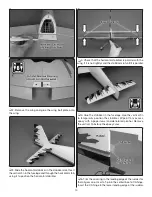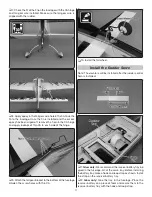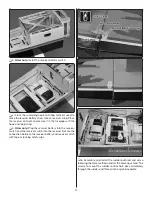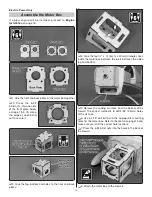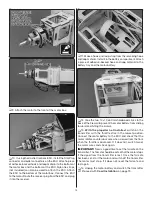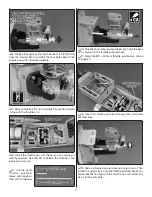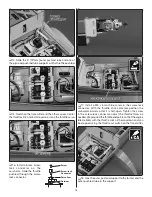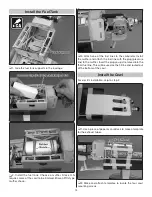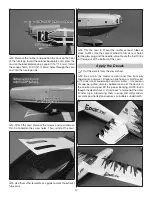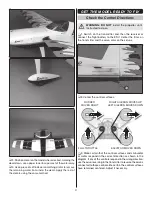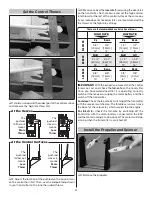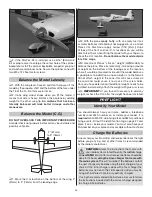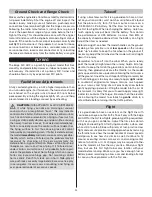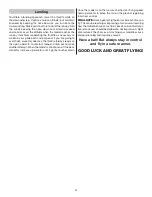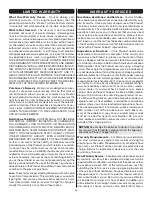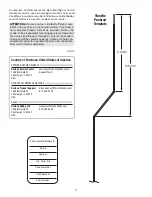
24
Ground Check and Range Check
Make sure the engine idles, transitions smoothly and maintains
full power indefi nitely. Shut the engine off and inspect the
model closely, making sure all fasteners, pushrods and
connections have remained tight and the hinges are secure.
Following the radio manufacturer’s instructions to ground-
check the operational range of your radio before the fi rst
fl ight of the day. This should be done once with the engine/
motor off and once with the engine/motor operating at various
speeds. If the control surfaces do not respond correctly,
do
not fl y!
Find and correct the problem fi rst. Look for loose
servo connections or broken wires, corroded wires on old
servo connectors, loose motor connectors or try relocating
the receiver antennas away from the motor battery or engine.
FLYING
The Edge 540 ARF is a great-fl ying sport model that fl ies
smoothly and predictably. However, it does not possess the
self-recovery characteristics of a primary R/C trainer and
should be fl own only by experienced R/C pilots.
Fuel Mixture Adjustments
A fully cowled engine may run at a higher temperature than
an un-cowled engine. For this reason, the fuel mixture should
be richened so the engine runs at about 200 rpm below
peak speed. By running the engine slightly rich, you will help
prevent dead-stick landings caused by overheating.
CAUTION:
(THIS APPLIES TO ALL R/C AIRPLANES):
If, while fl ying, you notice an alarming or unusual
sound such as a low-pitched “buzz,” this may indicate
control surface
fl utter.
Flutter occurs when a control surface
(such as an aileron or elevator) or a fl ying surface (such as
a wing or stab) rapidly vibrates up and down (thus causing
the noise). In extreme cases, if not detected immediately,
fl utter can actually cause the control surface to detach or
the fl ying surface to fail, thus causing loss of control
followed by an impending crash. If fl utter is detected, slow
the model
immediately
and land as soon as safely possible.
Identify which surface fl uttered (so the problem may be
resolved) by checking all the servo grommets for
deterioration or signs of vibration. Make certain all pushrod
linkages are secure and free of play. If it fl uttered once,
under similar circumstances it will probably fl utter again
unless the problem is fi xed. Some things which can cause
fl utter are: Excessive hinge gap; Not mounting control
horns solidly; Poor fi t of clevis pin in horn; Side-play of
wire pushrods caused by large bends; Excessive free play
in servo gears; Insecure servo mounting; and fl ying an
over-powered model at excessive speeds.
Takeoff
If using a brushless motor it is a good idea to have a timer
set on your transmitter, wrist watch or cell phone. We found
that the plane can fl y for 5-1/2 to 6 minutes or more on a
4S 3800 mAh LiPo battery. Set the timer for 5 minutes for
the fi rst few fl ights. When recharging the battery, note how
much capacity was put back into the battery. To maintain
the performance of LiPo batteries, no more than 80% of
the capacity should be drained from the battery on a fl ight.
Adjust the timer as needed.
Before taking off, see how the model handles on the ground
by doing a few practice runs at
low speeds
on the runway.
Hold “up” elevator to keep the tail wheel on the ground. If
necessary, adjust the tail wheel so the model will roll straight
down the runway.
Remember to take off into the wind. When you’re ready,
point the model straight down the runway, hold a bit of up
elevator to keep the tail on the ground to maintain tail wheel
steering, then gradually advance the throttle. As the model
gains speed, decrease up elevator, allowing the tail to come
off the ground. One of the most important things to remember
with a tail dragger is to always be ready to apply
right
rudder
to counteract engine/motor torque. Gain as much speed
as your runway and fl ying site will practically allow before
gently applying up elevator, lifting the model into the air. At
this moment, it is likely that you will need to apply more right
rudder to counteract the torque. Be smooth on the elevator
stick, allowing the model to establish a
gentle
climb to a
safe altitude before turning into the traffi c pattern.
Flight
It is a good idea to have an assistant on the fl ight line with
you to keep an eye on other traffi c. Take it easy with the Edge
540 ARF for the fi rst few fl ights, gradually getting acquainted
with it as you gain confi dence. Adjust the trims to maintain
straight and level fl ight. After fl ying around for a while, and
while still at a safe altitude with plenty of fuel, practice slow
fl ight and execute practice landing approaches by reducing
the throttle to see how the model handles at slower speeds.
Add power to see how she climbs as well. Continue to fl y
around, executing various maneuvers and making mental
notes of what trim or C.G. changes may be required to fi ne-
tune the model so it fl ies the way you like. Mind your fl ight
time, but use this fi rst fl ight to become familiar with your
model before landing. Make sure you have enough fuel or
battery power remaining to allow a second landing attempt
in case you have problems with the fi rst one.

